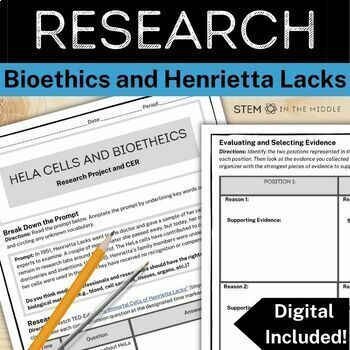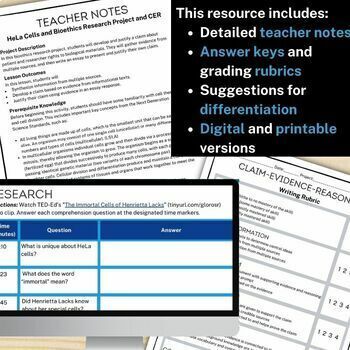Henrietta Lacks and Bioethics CER Research Project - Black History Month Project
- PDF
- Google Apps™
- Easel Activity

What educators are saying
Also included in
- Are you looking for independent research projects for life science or biology? Maybe you want to incorporate more reading and writing in your science class? Introduce your students to real world discoveries and amazing phenomena with these low-prep research projects. Students will gather informationPrice $14.07Original Price $16.75Save $2.68
Description
Looking to spark amazing discussion and engage your students in real-world debate, all while learning an important figure in Black History? Help your students learn about Henrietta Lacks, HeLa Cells, and the property rights of biological materials with this bioethics research project. Students will gather information from text and video sources. Then they will craft an argumentative essay using the CER format.
The lesson meets science, reading, and writing standards. Students begin with gathering evidence from a video and an article. The sources introduce students to Henrietta Lacks, HeLa cells, and the controversy surrounding patient rights to their own biological materials. Then students identify claims on both sides of the argument and describe the evidence and reasons that support each claim. This information is compiled in an easy-to-use graphic organizer. Finally, students create their own claims, outline their ideas, and produce an essay to justify their position on the property rights of biological materials.
The research project is independent and low-prep. The research project can be used for teacher-led lessons, but this resource also makes a great distance learning activity, ELA and Science cross-curricular project, Science sub plan, Black History Month project, holiday break packet, or extra credit assignment. Grab this activity today to save your planning and prep time, while knowing your students will be engaged and inspired while learning about Henrietta Lacks and HeLa cells!
_________________________________________________________________________
What’s included in the bioethics research project?
- Detailed teacher notes to assist with facilitation and lesson planning
- Printable PDF, Easel, and Google versions of the student worksheets
- Embedded links to quality background research video clips and an article
- Video guide and annotation key to support students with gathering evidence
- Graphic organizers to support the CER scientific writing process
- Easy-to-use grading rubric and answer key
Materials needed:
- Digital or printable copies of the student worksheets
- A copy of the background research article or device with internet access to read on
- A teacher computer with internet access or student devices to watch the video clip
_________________________________________________________________________
What are other teachers saying?
★★★★★
“This was a great resource to use with my Bioethics class. The instructions were clear, and it provided lots of scaffolding for the kids to be able to write the final essay.” -Melissa
★★★★★
“Love this!! I wanted to include more writing in my science class… This is perfect!” -Cindy
★★★★★
“This writing activity was great for my Honors students as it allowed them to use technology and critical thinking skills.” - Michelle
_________________________________________________________________________
How can the CER writing task be used in your classroom?
- Explore the field of bioethics
- Introduce your students to a real-world debate in the scientific community
- Assign a Black History Month project
- Use as a low-prep STEM or Science sub plan
- Create a cross-curricular ELA and Science project
- Practice scientific reading and writing with claim, evidence, reasoning (CER)
- Introduce real-world STEM disciplines and professions
- Develop 21st-century STEM skills, such as communication and critical thinking
- Assign extra credit and extension activities
_________________________________________________________________________
Feedback
Did you know you can earn credit towards future TPT purchases by leaving a review? If you download this product, please come back and leave a review at the product page or through “My Purchases” under “My Account” at TPT
_________________________________________________________________________
Product Recommendations
If you liked this product, check out:
_________________________________________________________________________
Let’s stay in touch!
If you have any questions about this product or my store, please send me an email. I’d love to hear from you! Follow me on TPT to learn about new products, sales, and freebies!







